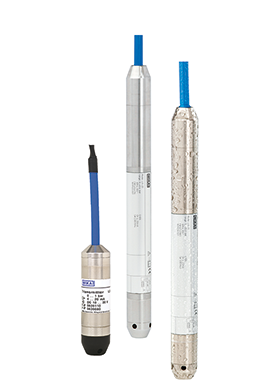

Hydrostatic level sensors (also referred to as submersible pressure transmitters) are very often installed in outdoor applications, primarily in the water and wastewater industries, where open bodies of water, deep wells or boreholes are monitored. A good connection to ground is essential when installing hydrostatic level sensors, since no grounding or poor grounding can result in destruction or damage to the level sensor.
Common failures from improper grounding
Hydrostatic level sensors in outdoor applications are connected via cables to the PLC or routed to local telemetric systems. These cables can act like an antenna, conducting electromagnetic or aerial voltage spikes down the wires to the sensor, causing an overload in the electronics, and thereby premature failure. The media that is measured may itself store energy like a capacitor. This is caused by lightning strikes, electrical surges, or simply static electricity. If there is not a sufficiently low impedance ground connection for the level sensor, this may cause voltage surges that flash through the electronics, causing them to overload and burn out.
Even if the voltage difference is too low to cause an overload of the electronics, it can cause electrolytic action due to the difference in voltage potential. This electrolytic action causes the metal housing material of the hydrostatic level sensor to be ‘eaten away’ over long-term operation. Electrolytic corrosion pits will form in the material, which can cause the diaphragm or housing to perforate, ultimately causing premature failure of the level sensor. This may be mistaken for chemical corrosion, but is in fact caused by the difference in voltage potential between the sensor and the surrounding liquid. Without a good ground, the sensor becomes a sacrificial anode and is inevitably eaten away.
How to ground and protect a hydrostatic level sensor
WIKA level sensors are available with optionally integrated lightning protection, which acts on dangerous differences in the voltage potential between electronics, cabling and transmitter body. This routes any harmful voltages to ground before they can damage the internal circuitry. However, if the grounding for the transducer is poor, it will still have nowhere else to go but into the electronics or body of the sensor, causing a premature failure.
In the case of metallic and plastic tanks, any isolated metal parts should be connected to a common ground with an impedance of less than 100 Ohms. In applications onboard ships, where metal tanks are always present, all the different ground potentials should be linked to the ship’s main ground point during docking. In lakes and reservoirs, a low-impedance connection to ground may be hard to achieve, but will be well worth the effort as it saves the hydrostatic level sensor electronics from failure. On artificial constructions or rock sites, even long copper spikes driven into the ground may not give a low enough impedance to ground. To solve this, earthing grids can be embedded into the ground to achieve a suitable resistance to ground.
Grounding of hydrostatic level sensors is a basic requirement for the reliable operation of level sensors, especially in outdoor applications, where overvoltage spikes and surges due to lightning strikes can occur regularly. Failure to provide adequate grounding can result in the failure of the level sensor.
| Tel: | +27 11 621 0000 |
| Email: | [email protected] |
| www: | www.wika.co.za |
| Articles: | More information and articles about WIKA Instruments |

© Technews Publishing (Pty) Ltd | All Rights Reserved